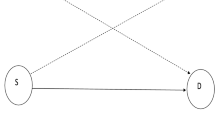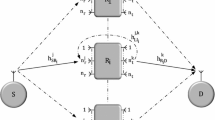Abstract
In this paper, we investigate two incremental amplify-and-forward relaying protocols in cognitive underlay networks. In the proposed protocols, whenever the secondary destination cannot receive the secondary source’s signal successfully, it requests a retransmission from one of M secondary relays. In the first protocol, we assume that a secondary relay with the Nth best channel gain to the secondary source is used to forward the received signal to the secondary destination. In the second protocol, relying on the quality of channels between the secondary relay and secondary destination and between the secondary relay and primary user, the Nth best relay is chosen for the retransmission. We derive exact closed-form expressions of the outage probability and average number of time slots for both protocols over Rayleigh fading channel. Finally, these mathematical expressions are then verified by Monte Carlo simulations.








Similar content being viewed by others
References
Laneman, J. N., & Wornell, G. W. (2003). Distributed space-time coded protocols for exploiting cooperative diversity in wireless networks. IEEE Transactions on Information Theory, 49, 2415–2425.
Laneman, J. N., Tse, D. N. C., & Wornell, G. W. (2004). Cooperative diversity in wireless networks: Efficient protocols and outage behavior. IEEE Transactions on Information Theory, 50, 3062–3080.
Bletsas, A., Khisti, A., Reed, D. P., & Lippman, A. (2006). A simple cooperative diversity method based on network path selection. IEEE Journal on Selected Areas in Communication, 24, 659–672.
Duy, T. T., & Kong, H. Y. (2012). Performance analysis of two-way hybrid decode-and-amplify relaying scheme with relay selection for secondary spectrum access. Wireless Personal Communications, pp. 1–22, April 2012.
Krikidis, I., Thompson, J., McLaughlin, S., & Goertz, N. (2008). Amplify-and-forward with partial relay selection. IEEE Communications Letters, 12, 235–237.
Suraweera, H. A., Michalopoulos, D. S., & Karagiannidis, G. K. (2009). Semi-blind amplify-and-forward with partial relay selection. Electronics Letters, 45, 317–319.
Ikki, S. S., & Ahmed, M. H. (2009). On the performance of adaptive decode-and-forward cooperative diversity with the Nth best-relay selection scheme. In Proceedings of IEEE global communication conference, pp. 1–6.
Ikki, S. S., & Ahmed, M. H. (2009). On the performance of amplify-and-forward cooperative diversity with the Nth best-relay selection scheme. In Proceedings of IEEE international conference on communication, pp. 1–6.
Khuong, H. V. (2012). Performance evaluation of underlay cognitive multi-hop networks over Nakagami-m fading channels. Wireless Personal Communications, pp. 1–12, June 2012.
da Costa, D. B., Aïssa, S., & Cavalcante, C. C. (2012). Performance analysis of partial relay selection in cooperative spectrum sharing systems. Wireless Personal Communications, 64, 79–92.
Lee, J., Wang, H., Andrews, J. G., & Hong, D. (2011). Outage probability of cognitive relay networks with interference constraints. IEEE Transactions on Wireless Communications, 10, 390–395.
Ding, H., Ge, J., da Costa, B., & Zhuoqin Jiang, D. (2011). Asymptotic analysis of cooperative diversity systems with relay selection in a spectrum-sharing scenario. IEEE Transactions on Vehicular Technology, 60, 457–472.
Li, D. (2011). Outage probability of cognitive radio networks with relay selection. IET Communications, 5, 2730–2735.
Duong, T. Q., Bao, V. N. Q., Alexandropoulos, G. C., & Zepernick, H. J. (2011). Cooperative spectrum sharing networks with AF relay and selection diversity. IET Electronics Letters, 47, 1149–1151.
de Oliveira Brante, G. G., Pellenz, M. E., & Souza, R. D. (2012). Spectrally efficient incremental relaying for coverage expansion in cellular networks with heterogeneous path-loss conditions. Wireless Personal Communications, 64, 811–829.
Guo, Y., Kang, G., Zhang, N., Zhou, W., & Zhang, P. (2010). Outage performance of relay-assisted cognitive-radio system under spectrum sharing constraints. Electronics Letters, 46, 182–184.
Gradshteyn, I., & Ryzhik, I. (2007). Table of integrals, series, and products (7th ed.). New York, London: Academic Press, Inc.
Author information
Authors and Affiliations
Corresponding author
Appendices
Appendix A: Derivation of (8)
Relying on [16], the CDF and PDF, respectively, of the RVs \(\psi _2\) are given as
Setting \(w = \gamma _3\); the outage probability \(\text{ P}_{\mathrm{IAF1}}^{\mathrm{out}}\) conditioned on \(\gamma _3\) is calculated as
where \(\rho = \gamma _{th} /Q\) and \(F_{\psi _1 | \gamma _3} \left(.\right)\) is the CDF of \(\psi _1\) conditioned on \(\gamma _3\), which can be given by using (5) as
Substituting (25), (26) and (28) into (27), we obtain (29) as
Now, we consider the integral \(I_1\) in (29). First, by setting \(y=1+\frac{\lambda _2 \gamma _{th} +\lambda _4 Q}{\lambda _2 \left({x-\gamma _{th}} \right)}\), we can respectively get
Therefore, by using the change of variable \(y=1+\frac{\lambda _2 \gamma _{th} + \lambda _4 Q}{\lambda _2 \left({x-\gamma _{th}}\right)}\) and results given in (30–32), we can express the integral \(I_1\) under the following form:
Substituting (33) into (29), we can rewrite \(\text{ P}_{\mathrm{IAF1|}\gamma _3}^{\mathrm{out}} \left(w\right)\) as follows:
where \(\Omega = \frac{\left({n+m-1}\right) \lambda _1 \rho }{\lambda _2 \gamma _{th} + \lambda _4 Q}\).
Because
\(\int \limits _1^{+\infty } {\frac{\exp \left({-\Omega \lambda _2 \left({1+\gamma _{th}}\right)wy}\right)}{y^{2}}} dy\!=\!\exp \left({\!-\!\Omega \lambda _2 \left({1\!+\!\gamma _{th}}\right)w} \right)\!-\!\Omega \lambda _2 \left({1\!+\!\gamma _{th}}\right)wE_1 \left({\Omega \lambda _2 \left({1\!+\!\gamma _{th}}\right)w} \right)\), where \(E_1 \left(.\right)\) is exponential integral, we obtain (35) from (34) as follows:
Similar to [14], the probability \(\text{ P}_{\mathrm{IAF1}}^{\mathrm{out}}\) can be formulated as
In addition, with a, b and c as positive constants, we have (33) as
Now, we substitute (35) into (36), then we use (37) to calculate the corresponding integral. After some careful manipulation, we obtain (8).
Appendix B: Derivation of (12)
Similar to (27), by setting \(w=\gamma _3\), the outage probability \(\text{ P}_{\mathrm{IAF2}}^{\mathrm{out}}\) conditioned on \(\gamma _3\) is calculated as
By using \(F_{\psi _3 |\gamma _3} \left(x\right)=1-\exp \left({-\frac{\lambda _3 wx}{Q}}\right)\) and (10) for (38), we obtain
Now, by applying the change of variable \(y=\frac{x+\kappa Q}{x-\gamma _{th}}\), we rewrite (39) as
where \(\Delta = \frac{\lambda _3 \rho }{\gamma _{th} + \kappa Q}\).
Using binomial expansion for \(\left({y+\frac{\kappa }{\rho }}\right)^{M-N}\) and \(\left({y-1}\right)^{N-1}\) in (40), we have
Applying [17, 3.351.4], for the integral \(J_1\) in (42) and \(E_1\left(x\right) = -E_i \left({-x}\right)\), we can obtain (42) as
Also, the probability \(\text{ P}_{\mathrm{IAF2}}^{\mathrm{out}}\) can be formulated as
Now, we substitute (42) into (43) and use [17, 6.228.2] with \(E_1\left(x\right)=-E_i \left({-x}\right)\) for the corresponding integrals to obtain (12).
Rights and permissions
About this article
Cite this article
Duy, T.T., Kong, HY. Performance Analysis of Incremental Amplify-and-Forward Relaying Protocols with Nth Best Partial Relay Selection Under Interference Constraint. Wireless Pers Commun 71, 2741–2757 (2013). https://doi.org/10.1007/s11277-012-0968-9
Published:
Issue Date:
DOI: https://doi.org/10.1007/s11277-012-0968-9




